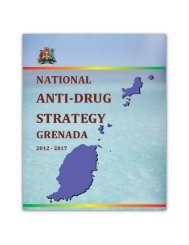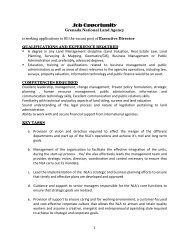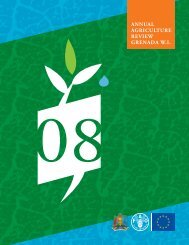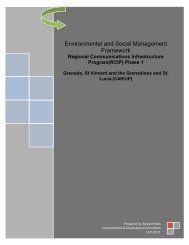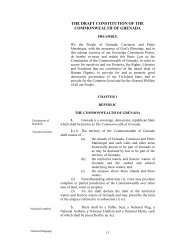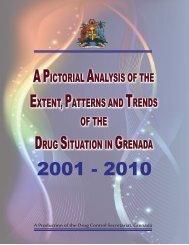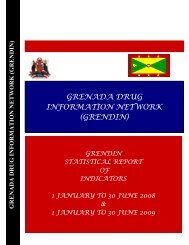The link between drug use and HIV/AIDS among young people in ...
The link between drug use and HIV/AIDS among young people in ...
The link between drug use and HIV/AIDS among young people in ...
You also want an ePaper? Increase the reach of your titles
YUMPU automatically turns print PDFs into web optimized ePapers that Google loves.
<strong>young</strong> persons, <strong>and</strong> a desire to live <strong>and</strong> enjoy life to the fullest dur<strong>in</strong>g youthful years plays itself out<br />
<strong>in</strong>to risky behavior through the practice of multiple sex partners. Youth also tend to engage <strong>in</strong> present<br />
gratification rather than future ga<strong>in</strong>. <strong>The</strong>y have little prospects for the future, possibly due to lack of<br />
adequate guidance by parental figures <strong>and</strong> poor adult role models. That coupled with their ignorance<br />
<strong>and</strong> immaturity spell trouble for the general society <strong>in</strong> terms of the socio-economic implications of<br />
such behaviors.<br />
<strong>The</strong> aforementioned sexual promiscuity of <strong>young</strong> persons comb<strong>in</strong>ed with their perceived benefits of<br />
alcohol <strong>and</strong> marijuana consumption, <strong>and</strong> the poor correlation <strong>between</strong> knowledge <strong>and</strong> behavioral<br />
modification all create an environment conducive to <strong>young</strong> persons contract<strong>in</strong>g the epidemic<br />
<strong>HIV</strong>/<strong>AIDS</strong>.<br />
Prevention Strategies<br />
It appears that most out of school youth <strong>and</strong> <strong>in</strong> school early teenage males are not aware of current<br />
prevention strategies. <strong>The</strong>refore programmes seem not to adequately target or reach these groups.<br />
It further appears that <strong>young</strong> persons may be dis<strong>in</strong>terested <strong>and</strong>/or unaffected by adult educators <strong>and</strong><br />
adult victims of risky behavior, which may result <strong>in</strong> the <strong>in</strong>terpretation <strong>and</strong> perception that <strong>drug</strong> ab<strong>use</strong><br />
<strong>and</strong> <strong>HIV</strong>/<strong>AIDS</strong> are “adult diseases”; not someth<strong>in</strong>g that is or can affect <strong>young</strong> persons.<br />
Similarly, community workers <strong>and</strong> educators whose characters are not exemplary (that is, known by<br />
attendees <strong>and</strong> students to be engag<strong>in</strong>g <strong>in</strong> <strong>drug</strong> <strong>use</strong> <strong>and</strong> deviant behavior) may not create the desired<br />
impact <strong>in</strong> the attempt to provide <strong>in</strong>formation, advice <strong>and</strong> encouragement towards positive behavior<br />
<strong>among</strong> the youth. It should be stressed that such <strong>in</strong>formation providers should consider the <strong>l<strong>in</strong>k</strong> that<br />
appears to be necessary <strong>in</strong> terms of provision of <strong>in</strong>formation <strong>and</strong> lifestyle presentation, given the social<br />
implications of these issues.<br />
It must be noted that parents should be the key <strong>in</strong> avoidance strategies. Some major focus must be<br />
made on address<strong>in</strong>g the role of parents <strong>in</strong> provid<strong>in</strong>g facilitat<strong>in</strong>g conditions for youth <strong>in</strong>volvement <strong>in</strong><br />
<strong>drug</strong> <strong>use</strong> <strong>and</strong> sex. Parents need to accept their role <strong>and</strong> responsibility towards youth development <strong>and</strong><br />
therefore measures must be put <strong>in</strong> place to develop citizens that are responsible <strong>and</strong> capable of sound<br />
decision mak<strong>in</strong>g skills.<br />
RECOMMENDATIONS<br />
<strong>The</strong> focus groups <strong>and</strong> key <strong>in</strong>formant <strong>in</strong>terviews revealed that <strong>people</strong> generally have <strong>in</strong>formation as to<br />
alcohol, <strong>drug</strong>s, risky sexual behavior, <strong>and</strong> <strong>HIV</strong>/<strong>AIDS</strong> but lack the <strong>in</strong>centives to focus on turn<strong>in</strong>g the<br />
acquired knowledge <strong>and</strong> <strong>in</strong>formation <strong>in</strong>to positive decision-mak<strong>in</strong>g <strong>and</strong> healthy life-styles to reduce<br />
their <strong>in</strong>volvement <strong>in</strong> risky lifestyles or behavioral patterns. <strong>The</strong> follow<strong>in</strong>g recommendations are made<br />
based on these f<strong>in</strong>d<strong>in</strong>gs:<br />
1. <strong>The</strong>re is need for massive national level media awareness programmes – billboards, television,<br />
radio, posters, brochures, pamphlets, newspaper articles, youth rallies <strong>and</strong> marches, motorcades<br />
– focus<strong>in</strong>g on the effects <strong>and</strong> impact of risky sexual behavior target<strong>in</strong>g youth <strong>and</strong> all vulnerable<br />
groups <strong>in</strong> society.<br />
2. <strong>The</strong> ideas <strong>and</strong> suggestions of <strong>young</strong> <strong>people</strong> on how to implement prevention programmes need<br />
to be taken <strong>in</strong>to consideration when plann<strong>in</strong>g such activities.<br />
49



